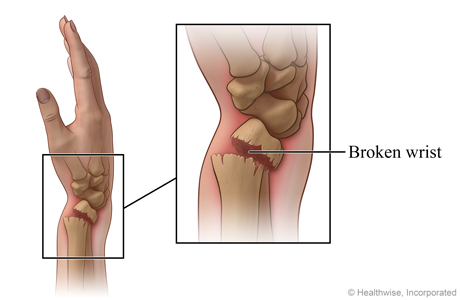Jump to
Broken wrist

A broken wrist (distal radius fracture) is a break in one or more of the bones that connect your forearm to your hand. Wrist fractures can range from a small, hairline crack to a bone or bones broken into two or more pieces.
How can you care for a broken wrist?
- Put ice or a cold pack on your wrist for 10 to 20 minutes at a time. Try to do this every 1 to 2 hours for the next 3 days (when you are awake). Put a thin cloth between the ice and your cast or splint. Keep your cast or splint dry.
- Follow the splint or cast care instructions your doctor gives you. If you have a splint, do not take it off unless your doctor tells you to. Be careful not to put the splint on too tight.
- Be safe with medicines. Take pain medicines exactly as directed.
- If the doctor gave you a prescription medicine for pain, take it as prescribed.
- If you are not taking a prescription pain medicine, ask your doctor if you can take an over-the-counter medicine.
- Prop up your wrist on pillows when you sit or lie down in the first few days after the injury. Keep your wrist higher than the level of your heart. This will help reduce swelling.
- Move your fingers often to reduce swelling and stiffness, but do not use that hand to grab or carry anything.
- Follow instructions for exercises to keep your arm strong.
Broken wrist: When to call
Call 911 anytime you think you may need emergency care. For example, call if:
- You are very sleepy, and you have trouble waking up.
Call your doctor now or seek immediate medical care if:
- You have new or worse pain.
- Your hand or fingers are cool or pale or change color.
- Your cast or splint feels too tight.
- You have tingling, weakness, or numbness in your hand or fingers.
Watch closely for changes in your health, and be sure to contact your doctor if:
- You do not get better as expected.
- You have problems with your cast or splint.
©2011-2025 Healthwise, Incorporated
The content above contains general health information provided by Healthwise, Incorporated, and reviewed by its medical experts. This content should not replace the advice of your healthcare provider. Not all treatments or services described are offered as services by us. For recommended treatments, please consult your healthcare provider.
